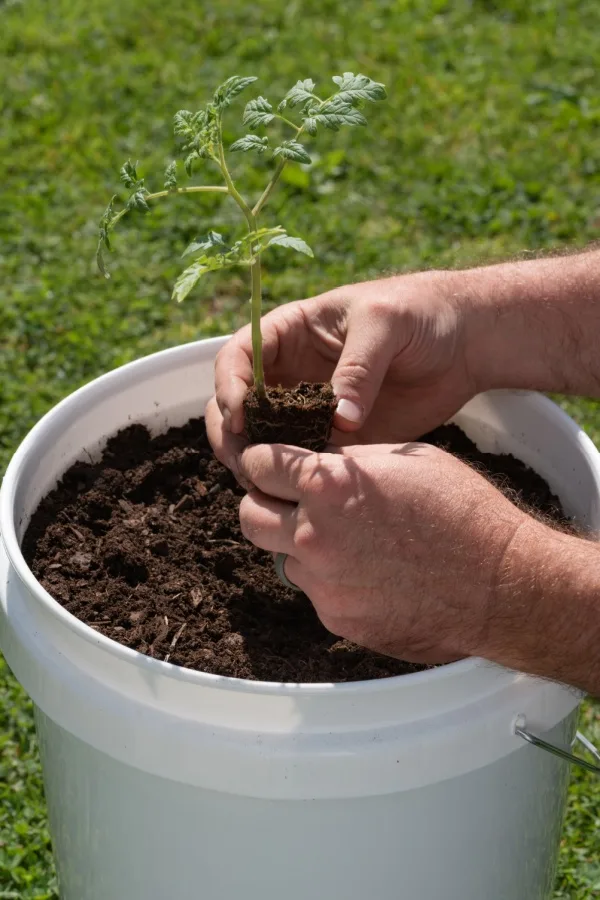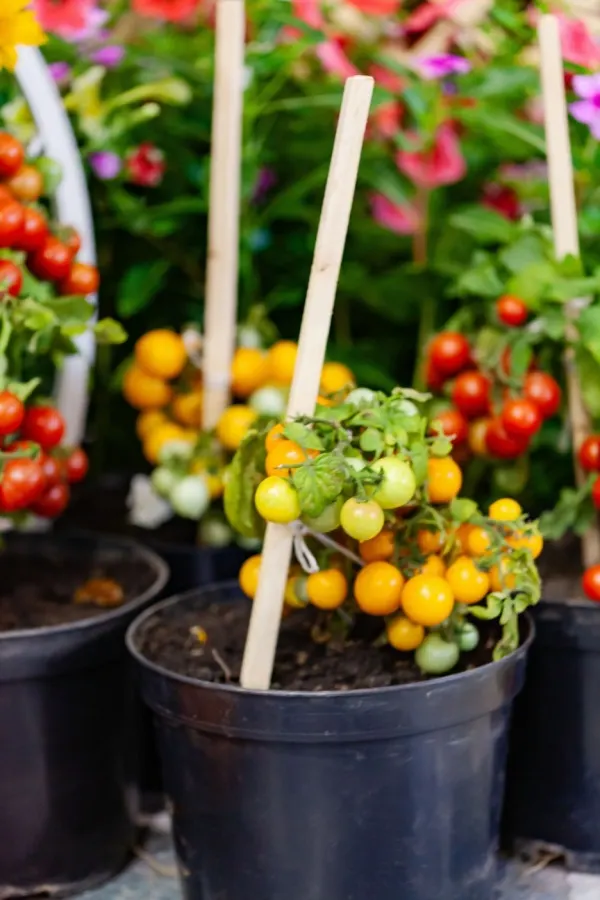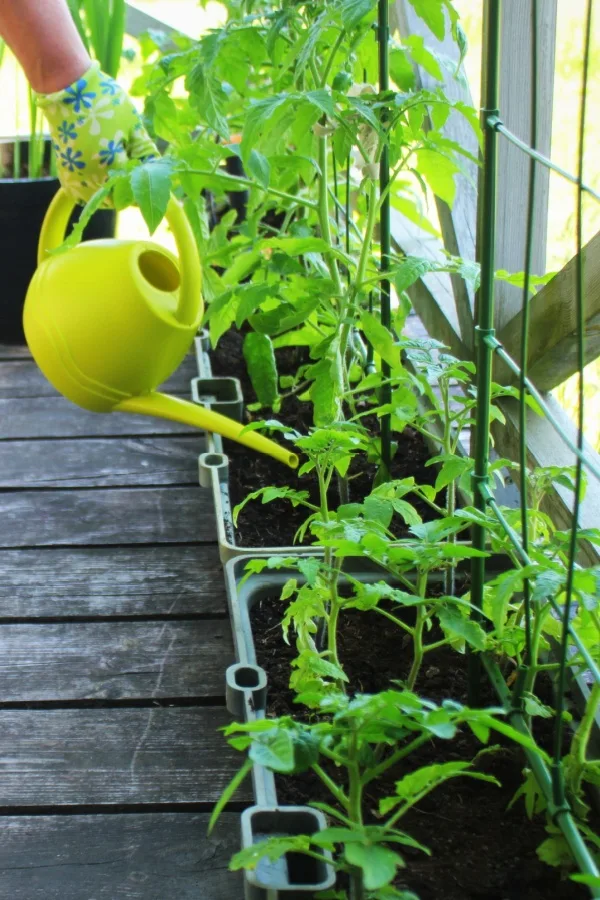When it comes to fertilizing tomatoes in containers or pots, there are a few simple keys to success that can power your plants to a bigger and better harvest than ever!
Tomatoes are heavy feeders. It takes a lot of nutrients and resources in order to grow healthy plants that push out ripe, juicy fruit all summer long. And if those nutrients aren’t replenished, your tomato plants can quickly start to suffer.
When growing tomatoes directly in the ground, their roots can grow and extend far into the soil to access additional nutrients and water. However, those that grow in pots or containers only have limited resources in a tiny space.

Even with dwarf tomato varieties, it doesn’t take long before all that power is zapped from the container soil. If it isn’t replenished throughout the growing season, your tomatoes will fail to produce lush foliage and set blooms – let alone be able to support growing and ripening fruit.
That’s where fertilizer comes into play. However, what you use to fertilize your tomatoes in pots and when you apply it will make a huge difference in their growth and success!
Advantages Of Growing Tomatoes In Containers
Growing tomatoes in pots and containers is starting to become more and more popular. Not only are there some amazing new varieties out there that are geared toward growing in smaller spaces but there are plenty of other advantages as well.
Being able to grow tomatoes in containers allows even people with the smallest of porches or patios to enjoy growing and harvesting fresh produce. As long as your space has at least 6 hours of direct sunlight, you can successfully grow tomatoes.
Another great advantage is that you don’t have to own a tiller or do the heavy chore of working the soil before planting. And when you grow tomatoes in containers, there is way less weeding as the season goes along compared to traditional in-ground gardens.

Probably the best advantage of all though is the reduction of pests and diseases. Tomatoes are susceptible to a wide range of different soil-borne diseases and pests that can overwinter in the soil. To prevent that in containers, you can just swap out the soil each season before adding your transplants.
From grow bags to 5-gallon buckets, about any container can be used depending on the tomato variety. But with containers, you will have to water and fertilize your tomato plants much more often. Thankfully, the task is simple to do as long as you keep a few tips in mind!
When And How To Fertilize Tomatoes In Pots
The key with tomatoes growing in containers is to start using fertilizer right from the beginning. Don’t allow the plants to start showing signs of need before providing them with energy. A steady supply of nutrients will allow plants to produce strong roots and full foliage as well as set the stage for plenty of blooms.
Low And Slow – Fertilize Tomatoes In Pots
For starters, in containers, you want to provide plants with energy in a steady supply but in small doses. While using fertilizer is good, over-fertilizing can be just as detrimental as doing nothing.

Plants that get too many nutrients at once will focus their energy on growing bigger and producing more foliage. At the same time, the plants put a halt on setting blooms – which, of course, means far fewer tomatoes to enjoy!
In addition, the plants will also push out larger roots. This is a big issue for plants growing in restricted spaces. This causes plants to become root bound, which will stop plants from being able to soak up moisture as well as nutrients from the soil.
The Right Fertilizers To Use – How To Fertilize Tomatoes In Pots
One of the best ways to provide tomato plants with a low and steady supply of nutrients is to use worm castings. Add just a cupful or two of castings around the base of each tomato after planting. Then, continue to add a cup or two at the base every month. See, “How To Use Worm Castings To Fertilize Tomato Plants”
Now, every time it rains or you hand water, the tomatoes in the pots will be fertilized with a low dose of nutrients. What’s best is that these nutrients are easily absorbed by the plant’s roots. This provides them with an instant boost of power. Product Affiliate Link: 100% Pure Organic Worm Castings Fertilizer
In addition to the worm castings, it’s also important to provide tomato plants in pots with a dose of liquid fertilizer every seven to ten days. But instead of using it at the full dose, use half the recommended amount.

By using a weaker solution, you can give plants a lighter dose of energy but apply it more frequently. This keeps the supply of nutrients steady as opposed to a big boost all at once.
When using commercial liquid fertilizers, look for an N-P-K ratio that has higher number of phosphorus and potassium. These two nutrients are key for fruit production. In addition, they also help keep plants healthy whereas nitrogen only focuses on foliage growth. Affiliate Product Link: Great Big Tomatoes – Soil and Tomato Fertilizer Booster
Proper Watering
Providing plants in pots with the correct amount of moisture is just as essential as fertilizer. In fact, both over and under-watering plants can be the biggest cause for container tomatoes to fail.
Just like container tomatoes only have so many nutrients in the soil, the same goes for moisture. The soil in containers and pots has a much higher chance of drying out compared to in-ground soil.

Too little water and plants will quickly dry out by the hot summer sun. On the flip side, too much water leaves tomato plants more susceptible to blossom end rot or root rot. So the key is to keep the soil as evenly moist as possible.
Keeping Soil Evenly Moist
The best way to do this is to check the soil moisture daily. Use your finger to check the moisture three to four inches below the soil. If the tip of your finger is moist, hold off on watering. If it’s dry, it’s time to give plants a good, deep soak of water.
Keep watering until the water starts to come out of the drainage holes. You can also use an inexpensive soil moisture meter to take the guesswork out of knowing when to water. Product Link: Soil 3-in-1 Soil Moisture Meter
With proper watering and providing tomato plants with a low and steady dose of liquid fertilizer, you can have great success growing tomatoes in pots and containers this summer! For more tips on growing tomatoes without a ‘traditional’ garden, see: How To Grow Tomatoes In Raised Beds – 3 Simple Secrets To A Big Harvest!
I Grow Tomatoes
Follow Our Facebook Page For Even More Great Tomato Growing Tips! I Grow Tomatoes Facebook Page
I Grow Tomatoes is a website created for those who love all things about tomatoes – from planting and growing – to cooking and canning! We publish two articles every week, 52 weeks a year. Sign up today to follow via email! This article may contain affiliate links.
